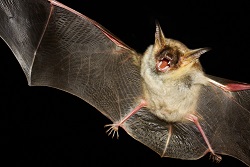Bat DNA could be the secret to a long and healthy life
With an average lifespan of 78 years and rising, Europeans can look forward to longer lives. But these lives may not necessarily be healthy, since the onset of age-related diseases has failed to follow this upward trend. To gain a better understanding of the ageing process, an international team of researchers conducted a study of different bat species. The results were recently published in the journal ‘Science Advances’. The study, which benefited from an EU research grant for the project AGELESS, looked at the telomeres of four different species of wild bats to determine what role, if any, they play in bat longevity. Among mammals, bats are the longest-lived species relative to their body size. In fact, of the 19 mammal species that live longer lives than humans when body size is factored in, 18 are bats. Using data gained from more than 60 years of field studies, the project team tried to find out whether telomeres shorten with age in the bat species Rhinolophus ferrumequinum, Miniopterus schreibersii, Myotis bechsteinii and Myotis myotis. Telomeres are the caps at the end of each strand of DNA that protect our chromosomes. As we age, telomeres get shorter and shorter until they can no longer do their job, which causes our cells to begin breaking down. Once this process is triggered, our tissues begin to degenerate and die. The bats were captured at different sites across Europe. Three-millimetre wing samples were taken from each bat before it was released. The samples were then flash-frozen in liquid nitrogen or dried using silica beads. The results of the telomere analyses showed that, just like in most mammals, telomeres shorten with age in the bat species R. ferrumequinum and M. schreibersii. However, no relationship between telomere length and age was found in the genus Myotis, which includes the longest-lived bat species studied to date. Some cells can combat telomere shortening by expressing telomerase, an enzyme that extends the telomeres of chromosomes. To discover how telomere length may be maintained in Myotis species, the scientists investigated telomerase expression in M. myotis, whose maximum life span (37 years) was much longer than the other three species studied. Interestingly, the tests showed no signs of telomerase expression in this bat. DNA repair genes Further tests were then conducted to compare the genome of Myotis species with those of 52 other mammals. Analyses of 225 genes associated with telomere maintenance identified 21 that may play a role in preventing telomere shortening in Myotis bats. ATM and SETX in particular, which are responsible for repairing and preventing DNA damage, may be the driving force behind the species’ remarkable longevity. If these genes are the reason why telomeres don’t shorten in Myotis species, then they might have excellent therapeutic potential, since bats rarely have cancer. The maintenance of telomere length without telomerase involvement is especially important for humans, since telomerase expression is found in about 90 % of human cancers. The AGELESS (Comparative genomics / ‘wildlife’ transcriptomics uncovers the mechanisms of halted ageing in mammals) project has helped to deepen understanding of the mechanisms that bats have evolved in order to give them their long lifespans. It has also brought scientists a step closer to discovering how to stop ageing and alleviate age-related illnesses in humans. For more information, please see: AGELESS project
Countries
Ireland



